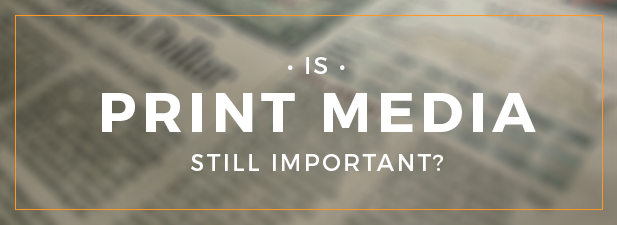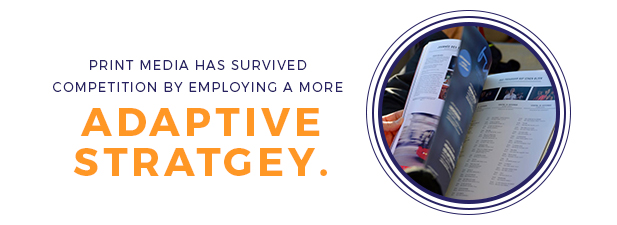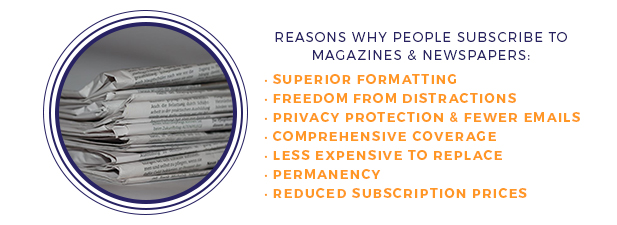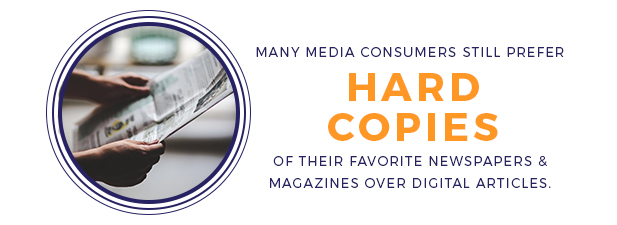
Newspapers and print media publications have existed in one form or another almost since the invention of the printing press. Yet, over the last century, industry experts have made bold predictions about print media, including a few scenarios where physical print publications no longer exist. Now that we live in an age when articles, images and videos can be populated onto a tiny screen nearly anywhere in the civilized world, ink and paper publications may not seem as vital as they once did.
But if you’re finding yourself reluctant to trade in your printed newspapers and magazines for the flat, cold pixels of a computer monitor, e-reader or smartphone screen, you’re not alone. While electronic media has certainly made substantial progress in the way American society receives its news content, polls indicated that tens of millions of readers still prefer to receive their news from print media sources.
A Return to Print Media
The demise of print media has been heralded since long before the introduction of handheld personal reading devices, but even with the inundation of smartphones and tablets, many media consumers still prefer hard copies of their favorite newspapers and magazines over digital articles. Here are some of the reasons if you are asking why read the news:
- Falling prices of newspapers and magazines
- Improved delivery services from vendors and secondary distribution outlets
- Increased availability of quality print publications at stores and newsstands
- Computer monitor and e-reader eye strain prompting readers to opt for physical print
- Tradition/nostalgia
- Preference for magazine formatting — as opposed to difficult-to-read cellphone versions of articles
- Less expensive to buy a subscription than pay for multiple individual downloads
- To add to personal media and cover art collections
- Beautiful photos and graphics
- Inconsistent electronic formatting in web versions
Importance of Print Media in Society
Most westerners have at least a nodding familiarity with Johannes Gutenberg, the man who once helped bring about the European Information Age of the Fifteenth Century by inventing a form of the printing press. While there had been other versions of the printing presses in use in China and Japan for thousands of years, these primitive machines had never been used in Europe in any meaningful way.
Prior to the invention of the Gutenberg press, books were hand-copied by scribes. This was a time-consuming process that made texts rare and costly. However, the Gutenberg press was capable of printing 42-line pages, making it possible to turn out hundreds of copies of a page at a time. With the increased availability of print, literacy rates throughout Western Civilization soared, and print became the primary way for delivering messages to the masses.
As both the machinery and processes for printing were perfected over the following four centuries, print media and publications evolved and became a more important part of the spread of information. And while competition among newspapers, magazines and journals intensified, it wasn’t until the twentieth century that print media faced its first meaningful competition from other communication sectors.
As wireless radio receivers became more affordable, radio networks began subscribing to the same wire services that provided newspapers across the country much of their information. This allowed the radio stations to run news broadcasts. Fearing the threat of competition from the rapidly expanding coverage of these radio networks, the traditional print media convinced the wire services to stop providing subscriptions to the station networks. This resulted in Big Radio limiting their news coverage, leaving print media with a virtual monopoly over the news — and coercive influence by the print media over wireless radio became known as the Press-Radio War.
In the following generations, print media has survived competition from radio, network, television, 24-hour cable news stations, email news services and the Internet by employing a more adaptive strategy, often diversifying into the very sectors that have threatened to steal their market share. But newspapers have largely survived because even in the face of stiff competition, there remains a market for print. Consumers may enjoy the speed and portability of online articles and electronic devices, but many also want the option of having a magazine delivered to their home or to pick up a newspaper from a vending machine or convenience store.

Why Do People Read Magazines and Newspapers?
For some types of research or media consumption, nothing beats Google or the webpage of a favored news outlet. The Internet is fast and provides massive amounts of information about a limitless variety of topics. But depending on your goals, you may prefer a printed publication as opposed to a pixilated torrent of data. Here are some of the reasons why people subscribe to magazines and newspapers:
 Superior Formatting
Superior Formatting
Some people just prefer being able to crack open a new magazine or spread out a crisp fresh newspaper across the table to sliding their finger across a glass screen. But aside from the sensory experience, a printed article looks different than one posted on a webpage. Most people are accustomed to turning the pages of a physical newspaper or magazine.
Browsing a webpage on a mobile device can be an exercise in frustration, depending on the number of pop-up ads and clickbait articles that are connected to the page. For some, that alone is enough to make them want to order hard copies of newspapers and magazines.
 Freedom from Distractions
Freedom from Distractions
At one time, people complained about how distracting print advertisements in newspapers and magazines were — that was before the Internet. Have you ever tried to read through an article or a list only to be diverted to another article or advertisement without knowing what you did to get there? Even with popup blockers and ad blockers, many websites still use intrusive, in-your-face advertisement techniques like these to try to drag readers to advertisements. Others will just distract you from the margins with bright coloring or animation.
Many sites prevent you from seeing your article without first watching a video or clicking on an ad. Print media doesn’t have the ability to require you to view its marketing campaigns. It merely displays the ad and allows you to decide what level of attention you want to give it.
Privacy Protection and Fewer Emails
More and more, newspapers and online magazines are requiring readers to subscribe with an email address and password to view their articles. This is usually so that they can bombard your email account with subscription offers, and once you’ve subscribed, they offer you extensions to those subscriptions. But in addition to marketing, they may also be gathering data to build subscriber profiles.
Recently, the federal government has voted to reverse privacy protection laws that prevented companies from compiling and selling subscriber lists to advertisers. When you purchase a physical print edition of a paper or magazine, you leave no trail to your IP address, and you generally aren’t required to share your email address.
Comprehensive Coverage
Newspapers assemble dozens of articles from a variety of sources. Magazines employ in-house or freelance writers to cover several closely related topics for each addition. If you’re researching something for which you don’t have an ongoing interest or you only have need for one particular article, it may not make sense to take out an annual subscription of the magazine that it’s in. If, on the other hand, you have an ongoing need for the type of information that a newspaper reports or a magazine covers, you should consider subscribing.
By reading a trade journal or magazine, you not only peruse the topics that you search out, but you also see what everybody else in your industry is reading. Knowing what’s being discussed among your colleagues gives you a competitive edge.
Less Expensive to Replace
While e-readers and tablets cost hundreds of dollars per unit, a newspaper usually costs under a dollar or two, and a magazine less than 10 dollars. For this reason, print media is the preferred choice of readers on the go who also have concerns about accidents or theft. Losing a $2.50 copy of the New York Times or spilling coffee on a newsstand copy of Newsweek doesn’t have the same financial impact as returning to your car and finding that your iPad has been stolen.
Permanency
Online articles and stories can be corrected and updated as new information comes in, but that can make it difficult to construct an accurate timeline of events. There’s also a growing trend of news webpages making articles unavailable after a period of time. If you preserve your magazines and newspapers, or clip articles from them, you will always be able to access the information when you need it.
Reduced Subscription Prices
The fact of the matter is that Americans don’t rely on news print as much as they once did. That’s good news for those of us who still do prefer physical copies of publications. Newspapers and magazines have lowered their prices as an inducement to bring in new subscribers or to encourage them to continue their subscriptions. This often makes print editions more cost effective than their digital counterparts.
Benefits of Reading the Newspaper
There are few educators who would argue against the merits of reading a newspaper on a daily basis. While reading, in general, helps one develop the mind, reading a newspaper provides the reader with a flow of information that’s impossible for books to keep pace with. Among the benefits that can only be obtained from a daily diet of newspaper reading are:
- Newspaper articles deliver comprehensive information on a variety of topics. Very few other information sources provide the scope and detail on so many separate and interconnected events.
- The information found in newspapers can assist you in important life decisions. Some of these include the best time to buy a house, whether it’s a good time to switch jobs, where you should invest and which political candidates you should support. They also inform you of sales and bargains, as well as provide coupons to help you make you aware of good deals and help you save money.
- Local newspapers provide insight as to the events that affect your community in a way that national news outlets can’t. When local politicians and civic leaders want to deliver a message, they go to the local newspapers and media outlets. When a local news story rises to state or national importance, the networks often start their research by contacting local reporters for assistance.
Print Media in Education
For years, educators have recognized the value of newspaper articles as a resource to supplement traditional textbooks. News stories can be used to demonstrate parallels between current events and historical lessons, to teach economic lessons, as fresh material to assign writing assignments, etc. By teaching students about the importance of media in our life, educators help produce a sharper, better informed electorate, which is one of the reasons why so many institutions of higher learning require their professors to include media-related assignments in their syllabi.
Many publications offer student-discount subscription rates to encourage readership in that demographic. If you’re attending college or a trade school, check to see if the magazine or newspaper you want has a student discount. The savings are often substantial.
The Purpose of Magazine Articles
If newspapers deliver a daily flood of information, then why read magazines? While newspapers and magazines are often lumped together under the general category of “periodicals,” the format and purpose of magazines are quite different than those of newspapers. Most newspapers are circulated on a daily basis, but the frequency of publication can be somewhat limiting. Newspapers have audiences with a wide array of interests. If it’s a local paper, its subscribers may want information on the news pertaining to their geographic region. National papers tend to cover business, politics, sports leagues and international events.
Because magazine editions are spaced out over a longer period of time, the writers and editors can dedicate more time to developing a story. Additionally, magazines tend to focus on a specific type of reporting, allowing them to dedicate more words to fewer stories. Some newspapers publish hundreds of stories per day — sometimes only consisting of a paragraph or two. Magazines tend to publish lengthier articles.

Not all newspaper readers enjoy magazine articles, and not all magazine subscribers read newspapers on a regular basis. Fortunately, the two formats are available independently of one another.
The Case for Hard Copies
Arguments that will successfully compel a person to do something that’s counter to their personal convenience are rare. If you’re a person who only occasionally reads a newspaper or magazine article when you want to learn more about a news story that crosses your television screen and has no hobbies or special interests that require additional reading, you may not see the need to receive a newspaper or magazine. Hard copies don’t benefit all readers equally. Many physical-print readers will even grudgingly admit that they prefer the speed of web articles, but they will stubbornly stick to their print publications for the simple reason that it’s one fewer thing that they have to do on their phone or computer.
If you are located in an apartment, hotel, office building or residence in New York City, we offer publication delivery on an ongoing basis or on-demand in an hour. Contact us to learn how you can start receiving your favorite magazines or newspapers.





